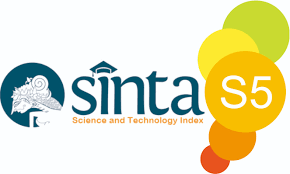Potential of Mangrove Ecosystem as a Tourism Object Development in Kaledupa Island
 Abstract views: 776
,
Abstract views: 776
,
 PDF downloads: 579
PDF downloads: 579
Abstract
Mangrove forests that live in coastal areas, besides being beneficial for human needs, also often clash with development interests such as ports, fish ponds, and tourist areas that threaten their sustainability. Wakatobi Regency has the potential of living natural resources in the form of coastal and marine resources which are quite large, including mangrove ecosystems, seagrass ecosystems and coral reef ecosystems. The purpose of this study is to analyze the potential of mangrove ecosystems and to design the development of mangrove forests as an ecotourism potential. This research is a descriptive-evaluative research, with a qualitative approach. This research is important as a consideration in the development of attractions, which are the main sector in Wakatobi Regency. Mangrove species that dominate throughout the Wakatobi region are Rhizophora spp, Avicennia spp. and Sonneratia spp. Based on the potential of each island in Wakatobi Regency, Kaledupa Island is a priority area to be developed into ecotourism. This study recommends the construction of several supporting facilities for ecotourism on Kaledupa Island. Suggestions and infrastructure include service facilities, trade facilities and accommodation facilities
Downloads
References
Azis, S. S. A., Sipan, I., Sapri, M., & Zafirah, A. M. (2018). Creating an innocuous mangrove ecosystem: Understanding the influence of ecotourism products from Malaysian and international perspectives. Ocean and Coastal Management, 165, 416–427. https://doi.org/10.1016/j.ocecoaman.2018.09.014
Basyuni, M., Bimantara, Y., Siagian, M., Wati, R., Slamet, B., Sulistiyono, N., Leidonad, R. (2018). Developing community-based mangrove management through eco-tourism in North Sumatra, Indonesia. In IOP Conference Series: Earth and Environmental Science (pp. 1–7). https://doi.org/10.1088/1755-1315/126/1/012109
Fisu, A. A. (2017). Potensi Demand Terhadap Pengembangan Kanal Jongaya & Panampu Sebagai Moda Transportasi (Waterway) Di Kota Makassar. Jurnal Manajemen Transportasi Dan Logistik. https://doi.org/10.25292/j.mtl.v3i3.68
Fisu, A. A., Didiharyono, D., & Bakhtiar. (2020). Economic & Financial Feasibility Analysis of Tarakan Fishery Industrial Estate Masterplan. IOP Conference Series: Earth and Environmental Science, 469, 1–7. https://doi.org/10.1088/1755-1315/469/1/012002
Fisu AA. (2016). Analisis dan Konsep Perencanaan Kawasan Pelabuhan Kota Penajam Sebagai Pintu Gerbang Kabupaten Penajam Paser Utara Kalimantan Timur. Pena Teknik: Jurnal Ilmiah Ilmu-ilmu Teknik. 1(2). 125-136
Giarno, G., Didiharyono, D., Fisu, A. A., & Mattingaragau, A. (2020). Influence Rainy and Dry Season to Daily Rainfall Interpolation in Complex Terrain of Sulawesi. In IOP Conference Series: Earth and Environmental Science. https://doi.org/10.1088/1755-1315/469/1/012003
Hakim, L., Siswanto, D., & Makagoshi, N. (2017). Mangrove Conservation in East Java: The Ecotourism Development Perspectives. Journal of Tropical Life Science, 7(3), 277–285. https://doi.org/10.11594/jtls.07.03.14
Hugé, J., Vande Velde, K., Benitez-Capistros, F., Japay, J. H., Satyanarayana, B., Nazrin Ishak, M., Dahdouh-Guebas, F. (2016). Mapping discourses using Q methodology in Matang Mangrove Forest, Malaysia. Journal of Environmental Management, 183(3), 988–997. https://doi.org/10.1016/j.jenvman.2016.09.046
Idajati, H., Pamungkas, A., & Vely Kukinul, S. (2016). The Level of Participation in Mangrove Ecotourism Development, Wonorejo Surabaya. Procedia - Social and Behavioral Sciences, 227, 515–520. https://doi.org/10.1016/j.sbspro.2016.06.109
Mijan Uddin, S. M., Rafiqul Hoque, A. T. M., & Abdullah, S. A. (2014). The changing landscape of mangroves in Bangladesh compared to four other countries in tropical regions. Journal of Forestry Research. https://doi.org/10.1007/s11676-014-0448-z
Murdiyarso, D., Purbopuspito, J., Kauffman, J. B., Warren, M. W., Sasmito, S. D., Donato, D. C., Kurnianto, S. (2015). The potential of Indonesian mangrove forests for global climate change mitigation. Nature Climate Change, 5, 1089–1092. https://doi.org/10.1038/nclimate2734
Murtini, S., Kuspriyanto, & Kurniawati, A. (2018). Mangrove area development strategy wonorejo as ecotourism in surabaya. Journal of Physics: Conference Series, 953, 012174. https://doi.org/10.1088/1742-6596/953/1/012174
Nugraha, B., Banuwa, I. S., & Widagdo, S. (2015). Perencanaan Lanskap Ekowisata Hutan Mangrove di Pantai Sari Ringgung Desa Sidodadi Kecamatan Padang Cermin Kabupaten Pesawaran. Jurnal Sylva Lestari, 3(2), 53–66. https://doi.org/10.23960/jsl2353-66
Santos, L. C. M., Gasalla, M. A., Dahdouh-Guebas, F., & Bitencourt, M. D. (2017). Socio-ecological assessment for environmental planning in coastal fishery areas: A case study in Brazilian mangroves. Ocean and Coastal Management, 138, 60–69. https://doi.org/10.1016/j.ocecoaman.2017.01.009
Wahyuni, S., Sulardiono, B., & Hendrarto, B. (2015). Strategi Pengembangan Ekowisata Mangrove Wonorejo, Kecamatan Rungkut Surabaya. Diponegoro Journal of Maquares, 4(4), 66–70.
Authors who publish with this journal agree to the following terms:
- The author (s) keeps copyright on any article.
- The author grants the journal, right of first publication with the work simultaneously licensed under a Creative Commons Attribution License that allows others to share the work with an acknowledgement of the work’s authorship and initial publication in this journal.
- Authors can enter separate, additional contractual arrangements for the non-exclusive distribution of the journal’s published version of the work (e.g., post it to an institutional repository or publish it in a book), with an acknowledgement of its initial publication in this journal.
- Authors are permitted and encouraged to post their work online (e.g., in institutional repositories or on their website) prior to and during the submission process, as it can lead to productive exchanges, as well as earlier and greater citation of published work.
- We distributed the article, and any associated published material under the Creative Commons Attribution-Share alike 4.0 International License




